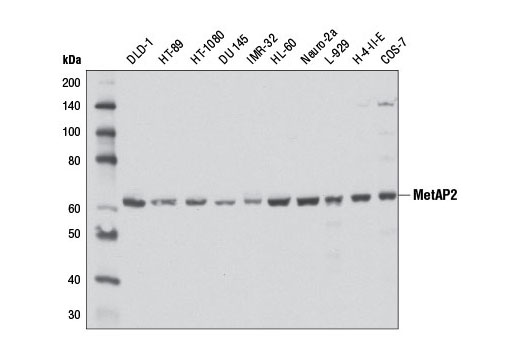WB
H M R Mk
Endogenous
63
Rabbit IgG
#P50579
10988
Product Information
Product Usage Information
| Application | Dilution |
|---|---|
| Western Blotting | 1:1000 |
Storage
Specificity / Sensitivity
Species Reactivity:
Human, Mouse, Rat, Monkey
Species predicted to react based on 100% sequence homology
The antigen sequence used to produce this antibody shares
100% sequence homology with the species listed here, but
reactivity has not been tested or confirmed to work by CST.
Use of this product with these species is not covered under
our
Product Performance Guarantee.
Hamster, Dog, Pig, Horse
Source / Purification
Monoclonal antibody is produced by immunizing animals with a synthetic peptide corresponding to residues surrounding Gly390 of human MetAP2 protein.
Background
Eukaryotic initiation factor 2 (eIF2)-associated glycoprotein, p67/methionine aminopeptidase 2 (MetAP2) is one of the three known MetAPs responsible for the co-translational processing of the N-terminal initiator methionine from nascent proteins in cells. MetAP2 regulates the rates of global protein synthesis by controlling the levels of eIF2α phosphorylation (1). MetAP2 has also been shown to bind Erk1/2 to inhibit their activation and activity, thus connecting the protein synthesis machinery with the cell signaling pathway mediated by Erk1/2 MAP kinases (2-4). Although MetAP2 is characterized as having aminopeptidase activity that removes the N-terminal methionine from nascent peptides in vitro, mounting evidence suggests that MetAP2 has no methionine aminopeptidase activity. Rather, MetAP2 possesses auto-proteolytic activity that can be inhibited by several small molecule inhibitors including anti-angiogenic drugs, fumagillin and its derivatives (5). It has also been demonstrated that O-GlcNAcylation of MetAP2 plays a major role in its stability, eIF2α binding, and maintenance of eIF2α phosphorylation (6).
MetAP2 knockout mice show embryonic lethality, suggesting its role in embryonic development and survival at the initiation of gastrulation (7). It is likely that lowering the levels of MetAP2 in mammalian cells causes cell growth inhibition and leads to apoptosis due to the high levels of eIF2α phosphorylation that inhibits global protein synthesis (8). During pathological or various stress conditions, MetAP2 dissociates from eIF2 subunits possibly due to its deglycosylation-induced autoproteolytic cleavage. As a result, eIF2α becomes hyperphosphorylated and global protein synthesis is inhibited. eIF2 complex-dissociated MetAP2 also displays a higher affinity toward Erk1/2, which results in the blockade of Erk1/2 activity. Thus, MetAP2 mediates cooperation between cell signaling and protein synthesis machinery to regulate cell growth and proliferation during physiological and pathological conditions (9). Research studies have shown higher expression of MetAP2 in human cancers, supporting the contention that MetAP2 plays a role in oncogenesis. For example, investigators have reported high MetAP2 expression in follicular lymphomas, large B-cell lymphomas, and Burkitt's lymphomas (10). Elevated expression of MetAP2 has also been reported in human colorectal adenocarcinomas (11).
- Datta, B. (2000) Biochimie 82, 95-107.
- Datta, B. et al. (2004) Arch Biochem Biophys 427, 68-78.
- Datta, B. et al. (2004) Biochemistry 43, 14821-31.
- Datta, B. et al. (2005) Exp Cell Res 303, 174-82.
- Bradshaw, R.A. and Yi, E. (2002) Essays Biochem 38, 65-78.
- Datta, B. et al. (1999) Exp Cell Res 250, 223-30.
- Yeh, J.R. et al. (2006) Proc Natl Acad Sci U S A 103, 10379-84.
- Datta, B. and Datta, R. (1999) Exp Cell Res 246, 376-83.
- Ghosh, A. et al. (2006) Exp Cell Res 312, 3184-203.
- Kanno, T. et al. (2002) Lab Invest 82, 893-901.
- Selvakumar, P. et al. (2004) Clin Cancer Res 10, 2771-5.
Species Reactivity
Species reactivity is determined by testing in at least one approved application (e.g., western blot).
Western Blot Buffer
IMPORTANT: For western blots, incubate membrane with diluted primary antibody in 5% w/v nonfat dry milk, 1X TBS, 0.1% Tween® 20 at 4°C with gentle shaking, overnight.
Applications Key
WB: Western Blotting
Cross-Reactivity Key
H: human M: mouse R: rat Hm: hamster Mk: monkey Vir: virus Mi: mink C: chicken Dm: D. melanogaster X: Xenopus Z: zebrafish B: bovine Dg: dog Pg: pig Sc: S. cerevisiae Ce: C. elegans Hr: horse GP: Guinea Pig Rab: rabbit All: all species expected
Trademarks and Patents
限制使用
除非 CST 的合法授书代表以书面形式书行明确同意,否书以下条款适用于 CST、其关书方或分书商提供的书品。 任何书充本条款或与本条款不同的客书条款和条件,除非书 CST 的合法授书代表以书面形式书独接受, 否书均被拒书,并且无效。
专品专有“专供研究使用”的专专或专似的专专声明, 且未专得美国食品和专品管理局或其他外国或国内专管机专专专任何用途的批准、准专或专可。客专不得将任何专品用于任何专断或治专目的, 或以任何不符合专专声明的方式使用专品。CST 专售或专可的专品提供专作专最专用专的客专,且专用于研专用途。将专品用于专断、专防或治专目的, 或专专售(专独或作专专成)或其他商专目的而专专专品,均需要 CST 的专独专可。客专:(a) 不得专独或与其他材料专合向任何第三方出售、专可、 出借、捐专或以其他方式专专或提供任何专品,或使用专品制造任何商专专品,(b) 不得复制、修改、逆向工程、反专专、 反专专专品或以其他方式专专专专专品的基专专专或技专,或使用专品开专任何与 CST 的专品或服专专争的专品或服专, (c) 不得更改或专除专品上的任何商专、商品名称、徽专、专利或版专声明或专专,(d) 只能根据 CST 的专品专售条款和任何适用文档使用专品, (e) 专遵守客专与专品一起使用的任何第三方专品或服专的任何专可、服专条款或专似专专

